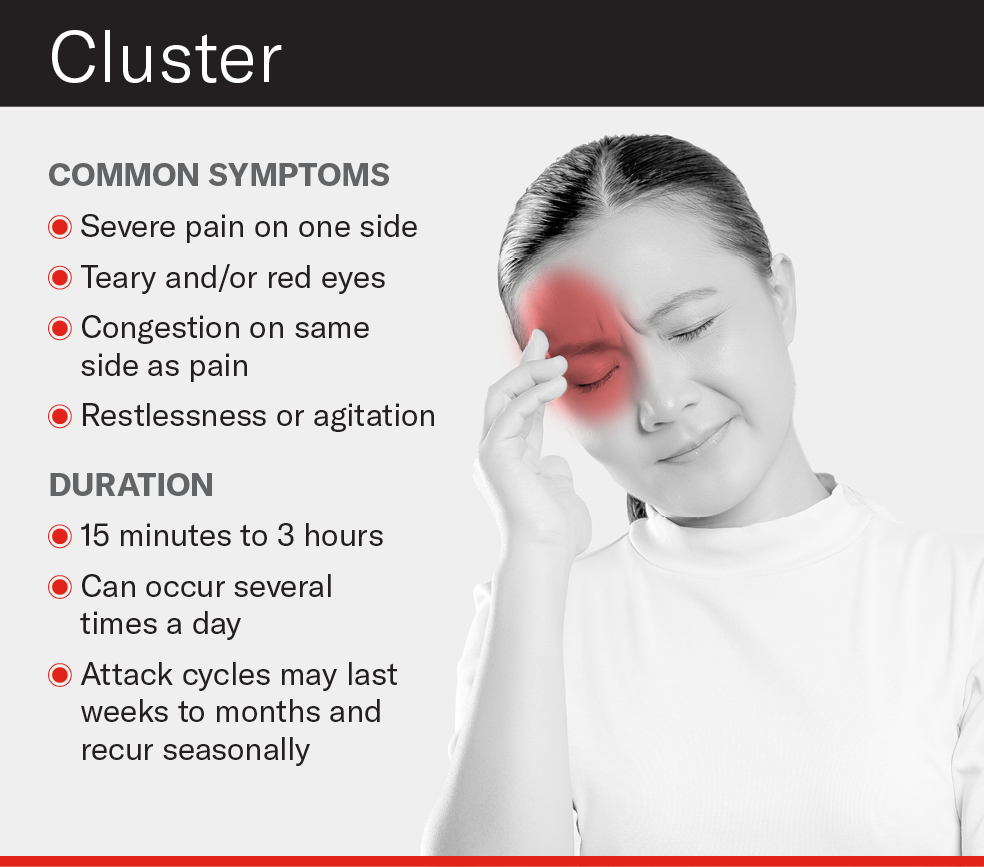Cluster headaches are among the most painful types of headaches. They strike suddenly and often recur in cycles.
Understanding the symptoms and causes of cluster headaches is crucial for effective management. These headaches are known for their intense pain, often described as piercing or burning. They typically affect one side of the head and occur in clusters over weeks or months.
Recognizing the triggers and knowing the signs can help in seeking timely treatment. Whether you're experiencing these headaches or know someone who is, learning more about them can make a significant difference. This blog post will guide you through the common symptoms and potential causes of cluster headaches, offering insights to help manage this debilitating condition.
Introduction To Cluster Headache
Cluster headaches cause severe pain, often around one eye. Triggers include alcohol, strong smells, or stress. Symptoms include watery eyes and nasal congestion.
Cluster headaches are one of the most painful types of headaches. They occur in cyclical patterns or clusters. This condition is relatively rare but affects many people worldwide. Understanding cluster headaches is crucial for managing and treating them effectively.What Is Cluster Headache?
A cluster headache is a severe headache disorder. It involves intense pain on one side of the head, often around the eye. This pain can last from 15 minutes to three hours. The headaches occur in clusters, meaning several attacks happen over weeks or months. These periods are followed by headache-free intervals. The exact cause of cluster headaches is unknown. However, it is believed to involve abnormalities in the brain's hypothalamus.Brief History And Recognition
Cluster headaches have been recognized for many years. The first known description dates back to the 17th century. However, it wasn't until the 20th century that the condition was studied in detail. Researchers have since identified its unique patterns and symptoms. This has helped in developing better treatment options. Today, cluster headaches are a well-recognized medical condition. They are acknowledged by healthcare professionals and researchers alike. ```:max_bytes(150000):strip_icc()/VWH-PaigeMcLaughlin-WhatisaClusterHeadache-Standard-87c962b6a28d4b1ab0359ed3ae5b696f.jpg)
Credit: www.verywellhealth.com
Symptoms Of Cluster Headache
Cluster headaches are known for their severe pain and recurrent nature. These headaches can disrupt daily life and are often described as one of the most painful conditions known to humans. Understanding the symptoms of cluster headaches is crucial for proper diagnosis and management.
Intense Pain Characteristics
Cluster headaches typically present with intense, sharp pain that is usually localized around one eye. This pain can also spread to other areas of the face, head, and neck. Patients often describe the pain as a burning or piercing sensation. The intensity of the pain is so severe that it can cause agitation and restlessness.
Other physical symptoms can accompany the pain, including:
- Red, watery eyes
- Swelling around the eye
- Runny or blocked nose
- Forehead or facial sweating
- Pale skin
Frequency And Duration
Cluster headaches occur in cyclical patterns, which is why they are termed "cluster" headaches. These headaches can occur frequently over a period of weeks or months, known as the cluster period. During this time, individuals might experience:
- One to eight headaches per day
- Attacks lasting from 15 minutes to three hours
- Headaches often occurring at the same time each day
Clusters are followed by a remission period where headaches stop completely. This remission can last months or even years.
Understanding these patterns can help in identifying and managing cluster headaches effectively.
Signs And Associated Symptoms
Cluster headaches are intensely painful and often appear suddenly. Recognizing the signs and associated symptoms can help in managing and seeking timely treatment. This section covers the key symptoms, including autonomic symptoms and behavioral changes.
Autonomic Symptoms
During a cluster headache, a variety of autonomic symptoms can occur. These symptoms affect the nervous system and are often unilateral, meaning they appear on one side of the head.
- Eye Redness: The eye on the affected side may become red and irritated.
- Tearing: Excessive tearing from the eye on the headache side.
- Nasal Congestion: A blocked or runny nose on the same side as the headache.
- Swelling: Swelling around the eye on the affected side.
- Pupil Constriction: The pupil may become smaller on the side of the pain.
- Facial Sweating: Increased sweating on the forehead or face on the side of the headache.
Behavioral Changes
Cluster headaches can also lead to noticeable behavioral changes. These changes are often due to the severe pain and the body's response to it.
- Restlessness: Patients often feel restless and may pace or rock back and forth.
- Agitation: There may be a sense of agitation or inability to stay still.
- Irritability: Increased irritability due to constant pain.
- Insomnia: Difficulty sleeping during a cluster period.
Understanding these signs and symptoms can help in diagnosing and managing cluster headaches effectively. Recognizing the autonomic symptoms and behavioral changes is crucial for timely medical intervention.
Causes Of Cluster Headache
Cluster headaches are a severe type of headache. Understanding their causes can help in managing them better. These headaches are often sudden and intense. They typically occur in patterns or clusters.
Genetic Factors
Genetics play a crucial role in cluster headaches. Family history increases the risk. Some genes may make you more prone to these headaches. Research continues to explore this link. Understanding your family's medical history can be useful.
Environmental Triggers
Environmental factors also contribute to cluster headaches. Strong smells like perfume or paint can trigger them. Alcohol, especially beer and wine, is another common trigger. Changes in sleep patterns can also play a part. Even seasonal changes, like shifts in weather, may affect them. Being aware of these triggers can help in avoiding them.
Pathophysiology
Cluster headaches are known for their severe and recurrent pain. Understanding the pathophysiology of cluster headaches is crucial. This involves studying the underlying mechanisms and brain structures involved.
Role Of Hypothalamus
The hypothalamus plays a key role in cluster headaches. It regulates many body functions. This includes sleep and circadian rhythms. During a cluster headache, the hypothalamus shows increased activity. This suggests its involvement in triggering the pain.
Neurovascular Mechanisms
Neurovascular mechanisms also contribute to cluster headaches. This involves the interaction between nerves and blood vessels. During an attack, blood vessels in the brain expand. This causes intense pain. The trigeminal nerve, a major facial nerve, gets activated. This activation leads to the release of chemicals that cause inflammation.
Understanding these mechanisms helps in developing better treatments. It helps in alleviating the severe pain associated with cluster headaches.
Diagnosis And Assessment
Accurate diagnosis and assessment are critical for managing cluster headaches. This ensures that patients receive appropriate treatment and relief. Understanding the specific criteria and differentiating it from other conditions is essential for healthcare professionals.
Diagnostic Criteria
The diagnostic criteria for cluster headaches are specific. The International Headache Society (IHS) provides guidelines.
- Severe or very severe unilateral headache
- Orbital, supraorbital, or temporal pain
- Headaches lasting 15 to 180 minutes
- Occurs in bouts (clusters) lasting weeks to months
Patients also exhibit at least one of the following:
- Conjunctival injection
- Nasal congestion
- Eyelid edema
- Forehead and facial sweating
- Sensation of restlessness or agitation
Differential Diagnosis
Cluster headaches can be mistaken for other conditions. Proper differential diagnosis is essential.
| Condition | Key Differences |
|---|---|
| Migraine | Longer duration, aura, nausea |
| Paroxysmal Hemicrania | Shorter duration, responds to indomethacin |
| Trigeminal Neuralgia | Electric shock-like pain, triggered by touch |
Clinicians use imaging studies and patient history to rule out other causes. Accurate diagnosis ensures effective treatment and better outcomes.
Treatment Options
Cluster headaches are incredibly painful and can disrupt daily life. Effective treatment can help manage the pain and reduce the frequency of attacks. This section explores both acute treatments and preventive measures for cluster headaches.
Acute Treatments
Acute treatments aim to relieve the pain during an attack. Quick and effective treatment is crucial.
- Oxygen Therapy: Inhaling pure oxygen can provide relief. Patients use a mask to breathe in oxygen for about 15 minutes.
- Sumatriptan Injections: This medication is effective for many. It can be self-administered and works quickly.
- Zolmitriptan Nasal Spray: This is another option for quick relief. It is sprayed into the nostrils.
- Lidocaine Nasal Drops: Applied directly into the nose, it can reduce pain. It acts faster than oral medications.
Preventive Measures
Preventive measures are essential to reduce the frequency and severity of attacks. They focus on long-term management.
- Verapamil: This is a common preventive medication. It helps reduce the number of headaches.
- Corticosteroids: These medications are used for short-term prevention. They are effective but have side effects.
- Lithium: This drug is another option for prevention. It is usually used in low doses.
- Melatonin: This natural hormone can help. Taking it before bedtime may reduce nighttime attacks.
- Nerve Blocks: This involves injecting medication near the nerves. It can provide longer relief.
Both acute and preventive treatments are essential for managing cluster headaches. Consult a healthcare provider to find the best approach.

Credit: healthmatters.nyp.org
Living With Cluster Headache
Living with cluster headaches can be a daily challenge. These headaches are often described as the most painful type of headache. They can disrupt your life, making simple tasks difficult. Understanding how to manage your symptoms can improve your quality of life. Below are some effective strategies and support systems to help you cope.
Coping Strategies
Managing cluster headaches involves various coping strategies. One effective approach is maintaining a regular sleep schedule. Sleep consistency can reduce headache episodes. Avoiding triggers like alcohol and strong smells can also help. Medication prescribed by doctors can provide relief during attacks. Keeping a headache diary can help identify and avoid triggers. Deep breathing and relaxation exercises can reduce stress and pain.
Support Networks
Support networks play a crucial role in managing cluster headaches. Family and friends can offer emotional support. Joining a support group can connect you with others who understand your struggles. Online communities and forums provide a platform to share experiences and tips. Talking to a mental health professional can also be beneficial. They can provide coping strategies and emotional support.
Living with cluster headaches requires a comprehensive approach. Combining coping strategies with a strong support network can make a significant difference. You don't have to face this challenge alone.
Frequently Asked Questions
What Are The Main Symptoms Of Cluster Headaches?
Cluster headaches cause severe, burning pain around one eye. They can also cause tearing, redness, and nasal congestion.
How Long Do Cluster Headache Attacks Last?
Cluster headache attacks typically last between 15 minutes to 3 hours. They occur several times a day.
What Triggers Cluster Headaches?
Common triggers include alcohol, strong smells, and extreme temperatures. Stress and certain medications can also trigger attacks.
Are Cluster Headaches Hereditary?
Yes, cluster headaches can run in families. Genetics may play a role in their occurrence.
Conclusion
Understanding cluster headache symptoms and causes is crucial. These headaches are intense. They affect daily life significantly. Identifying triggers can help manage the pain. Consult a healthcare provider for proper diagnosis and treatment. Early intervention can lessen the impact. Stay informed and proactive about your health.
This knowledge empowers you to seek timely help. Remember, you are not alone in this struggle. Relief is possible with the right approach.






